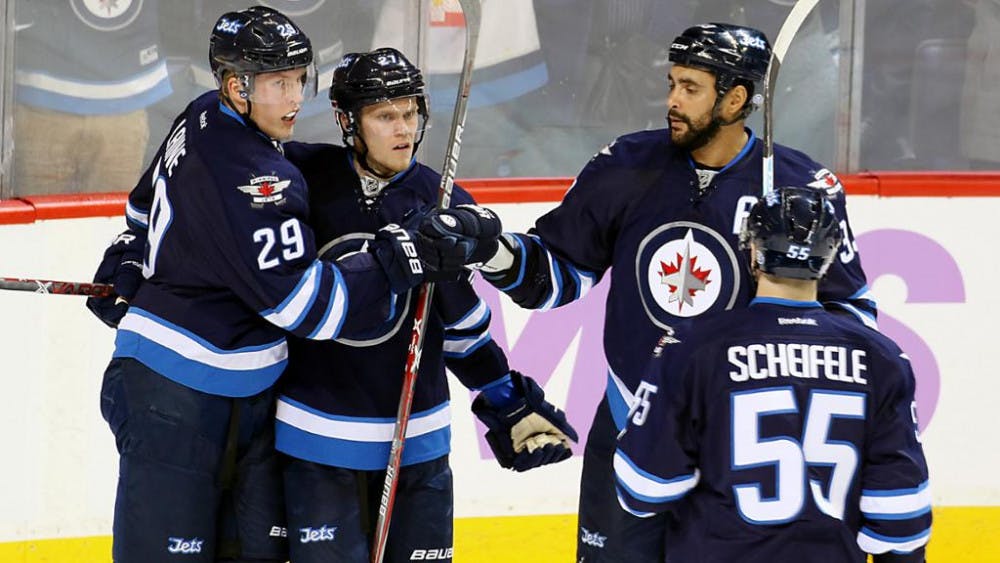When the Atlanta Thrashers relocated and became the Winnipeg Jets in 2011, the NHL was forced into reconsidering the entire scheme of the league. It was the second re-location of an Atlanta NHL franchise, and the move raised competitive and logistical issues to commissioner Gary Bettman, the NHL Players Association and the Board of Governors to work together and realign the league, issues that were not dealt with successfully.
While conducting the move, the NHL wanted to accommodate the Detroit Red Wings and the Columbus Blue Jackets, two franchises that had occupied the Western Conference despite residing in the Eastern Conference geographically.
[caption id="attachment_23176" align="aligncenter" width="838"] Photo via NHL.com[/caption]
The groups settled on a four-division system, which was a stark difference from the six-division system that had been in place since 1998. The Western Conference, consisting of the Central Division and the Pacific Division, had 14 teams at the start of realignment, but is now up to 15 with the addition of the Vegas Golden Knights this season. The Eastern Conference has 16 teams and is split up between the Metropolitan Division and the Atlantic Division.
The change allowed for the introduction of Winnipeg, but did not account for one important aspect: the Stanley Cup Playoffs.
The way the new playoff format is set up, three teams from each division make the postseason in addition to two wildcard teams from each conference. For both the Eastern and Western Conference, the top teams in each division play the wildcards, and the two divisional teams play one another.
Many problems have surfaced with the arrangement. For one, it leads to divisional rivals playing each other in the first or second rounds of the playoffs, rather than in the all-important third round. The Pittsburgh Penguins and Washington Capitals, two perennial powerhouses, have played each other in the second round in three straight years.
This season, the two top teams in the league, the Nashville Predators and Winnipeg Jets, are facing each other in round 2. The next two best, the Boston Bruins and Tampa Bay Lightning, are playing each other as well. This issue arises year after year, creating an uneven playing field in the third round, the penultimate round of the playoffs.
Many teams, primarily in stronger divisions such as the Metropolitan and the Central, can aim to get a specific wildcard spot rather than a divisional spot for the playoffs. For them, it could be much easier to take a lower seed and go through a weaker division than play within their own division. It is a distinct form of tanking that is unique to the NHL because of its corrupted playoff format.
A team in one division could have 95 points in a season, but have a lower seed than a team with 90 points if the divisions are unbalanced. That did not happen this year, but it did in 2017 when the New York Rangers had 102 points and finished in a lower seed than the Ottawa Senators, who had 98 points, as well as the Boston Bruins who had 95 points.
If the NHL wants to see long-term success, the playoff format needs to be changed drastically. Adjusting qualification so the top two seeds are the division leaders and the remaining six seeds are simply the best teams would make for more balanced competition. This change could lead to instances where only one team in a division makes the playoffs, but that is a worthy price to pay to even the playing field.
No matter what the league decides, some sort of change must be made. The introduction of a proposed Seattle expansion team in 2020 will provide an optimal time to realign and finalize the playoff format.
Kevin Kopf is a journalism major from Baldwin, N.Y. He can be reached at kevin.kopf@student.shu.edu or on Twitter @KMKTNF.
Photo via NHL.com[/caption]
The groups settled on a four-division system, which was a stark difference from the six-division system that had been in place since 1998. The Western Conference, consisting of the Central Division and the Pacific Division, had 14 teams at the start of realignment, but is now up to 15 with the addition of the Vegas Golden Knights this season. The Eastern Conference has 16 teams and is split up between the Metropolitan Division and the Atlantic Division.
The change allowed for the introduction of Winnipeg, but did not account for one important aspect: the Stanley Cup Playoffs.
The way the new playoff format is set up, three teams from each division make the postseason in addition to two wildcard teams from each conference. For both the Eastern and Western Conference, the top teams in each division play the wildcards, and the two divisional teams play one another.
Many problems have surfaced with the arrangement. For one, it leads to divisional rivals playing each other in the first or second rounds of the playoffs, rather than in the all-important third round. The Pittsburgh Penguins and Washington Capitals, two perennial powerhouses, have played each other in the second round in three straight years.
This season, the two top teams in the league, the Nashville Predators and Winnipeg Jets, are facing each other in round 2. The next two best, the Boston Bruins and Tampa Bay Lightning, are playing each other as well. This issue arises year after year, creating an uneven playing field in the third round, the penultimate round of the playoffs.
Many teams, primarily in stronger divisions such as the Metropolitan and the Central, can aim to get a specific wildcard spot rather than a divisional spot for the playoffs. For them, it could be much easier to take a lower seed and go through a weaker division than play within their own division. It is a distinct form of tanking that is unique to the NHL because of its corrupted playoff format.
A team in one division could have 95 points in a season, but have a lower seed than a team with 90 points if the divisions are unbalanced. That did not happen this year, but it did in 2017 when the New York Rangers had 102 points and finished in a lower seed than the Ottawa Senators, who had 98 points, as well as the Boston Bruins who had 95 points.
If the NHL wants to see long-term success, the playoff format needs to be changed drastically. Adjusting qualification so the top two seeds are the division leaders and the remaining six seeds are simply the best teams would make for more balanced competition. This change could lead to instances where only one team in a division makes the playoffs, but that is a worthy price to pay to even the playing field.
No matter what the league decides, some sort of change must be made. The introduction of a proposed Seattle expansion team in 2020 will provide an optimal time to realign and finalize the playoff format.
Kevin Kopf is a journalism major from Baldwin, N.Y. He can be reached at kevin.kopf@student.shu.edu or on Twitter @KMKTNF.





